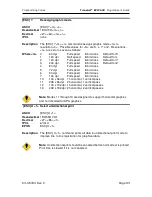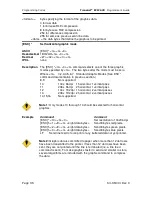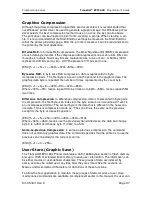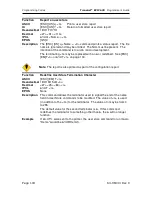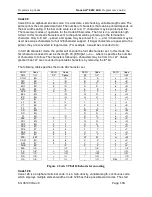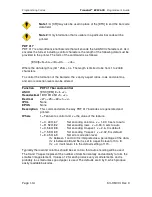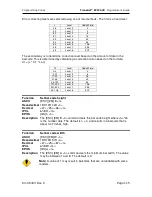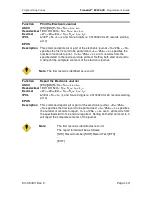
&&
&
'
&&
8 ,
! -
5
,
The user macro feature works by inserting the macro data buffer into the printer data
stream when the print user-store data command is encountered.
Macros can be any data normally sent to the printer including graphics. (Note: user-store
maintenance and inquire commands may not be included in the macro definitions.) The
printer stores macro data in a RAM-based storage buffer as it is received and
processed. The storage buffer may then be saved to a flash-based user store or inserted
into the print data stream. If a macro is recalled from user store, it is expanded into the
macro buffer and replaces whatever is currently there.
Programming Considerations
The flash (nonvolatile) memory has a limited number of write cycle operations.
Consequently, the number of saves should be limited. The buffer should not be saved on
a transaction by transaction basis, but rather a maximum of once per day.
The buffer is initially about 16K
5
bytes long. All commands
6
and print data are placed in
the buffer and must be included in the size limits. The printer does not indicate when the
buffer is full. The application must make sure that the buffer is not overfilled. The printer
simply stops saving information when it is full. As the buffer fills, the input data is printed
normally. The effect of the macro start command is to clear the buffer and to start to
save the input data. The macro stop command stops saving data and initializes internal
pointers for the next print. To store the data in the nonvolatile flash, it must be named
and saved by one of the user-store save commands.
When the macro buffer is inserted into the data stream, configuration commands (like
font or pitch changes) remain in effect after the macro is processed. Illegal commands
are placed in the buffer and take up space.
Horizontal graphics should be sent to the printer compressed. If the data is not
compressed, it is saved in the macro buffer. If the buffer is saved into the user-store
nonvolatile flash, there must be enough room in the user store for all of the data. As
user-store space is used, the macro buffer will be larger than the available space in user
store. Only the used space is saved, but it is possible to define a macro that does not fit
in the remaining user-store space.
5
The actual buffer is smaller because of the overhead.
6
IPCL commands are converted by the printer into an equivalent [ESC] code and then placed in
the save buffer. The equivalent [ESC] code should be used to calculate the size of the save
buffer data.
Содержание EPIC 630
Страница 1: ......
Страница 9: ......
Страница 10: ...This page intentionally left blank...
Страница 16: ...4 7 8 5 This page intentionally left blank...
Страница 17: ......
Страница 18: ...This page intentionally left blank...
Страница 30: ......
Страница 31: ...This page intentionally left blank...
Страница 37: ......
Страница 38: ...This page intentionally left blank...
Страница 41: ......
Страница 42: ...This page intentionally left blank...
Страница 57: ...8...
Страница 162: ...8 5 1...
Страница 163: ...8 This page intentionally left blank...
Страница 173: ...8 This page intentionally left blank...
Страница 174: ......
Страница 175: ......
Страница 176: ...5 This page intentionally left blank...
Страница 179: ...5 0 1...
Страница 180: ...This page intentionally left blank...
Страница 194: ......
Страница 196: ......



